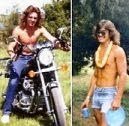"The Laetoli Footprints" were discovered
in 1976 at Laetoli, an archaeological site in northern Tanzania, where the prints
of three hominins -- ancient human ancestors and most likely Australopithecus
afarensis -- were preserved and fossilized in the ash fall of a volcanic
eruption some 3.63 -- 3.85 million years ago. They represent the oldest hominin
footprints yet discovered on the planet. It does not require a great deal of
imagination when physically present at such a place to feel the
lingering existence of the beings who made the prints and to visualize their
trek. The photograph is from a reproduction at the Field Museum, Chicago, by
James St. John. The video is here because I love the song and I love the voice
singing it and, mostly, because if fits my mood. It is mislabeled,
incidentally. The singer is not Cher. It is Kelly Van Hoose Smith, who played
Cher in a 1999 Sonny and Cher biopic.
Sort of lost without a time travel
machine
My usual routine includes
taking my "puppy companion" -- Buddy -- outside before we call it a day. The usual time
is around 1:00 a.m. -- give or take an hour either direction. About one-half an
inch of new-fallen, moist snow was on the ground last night. As I walked through it, I noted the
sharp, distinct footprints left behind. Between then and this morning, no more
snow had arrived and the prints remained -- still sharp and distinct.
As I retraced the path this morning of hours
earlier, I fancifully wondered if I might encounter myself on the earlier trek.
My mind then went to, "The Lincoln Hunters," a long-ago science fiction novel by
Wilson Tucker. The story, set in the year 2578, details the journey of historian
Benjamin Stewart from an oppressive society of that era, who travels back in
time to record Abraham Lincoln's Lost Speech of May 19, 1856, in Bloomington,
Illinois. The novel contains a vivid description of Lincoln in the early stages
of his career as seen through the eyes of Stewart, a man from the sort of distant future.
Other than being a superb tale
with a number of historical side trips, the novel also sets forth the "classic theory"
that two copies of a person cannot exist in the same location at the same time. Stewart
has to make two trips to achieve his mission and witnesses his earlier self
disappear .... which means author Wilson buys into the theory of occupation of the same space at the same time.
My fanciful being then wondered
which of us -- me or my earlier self -- would vanish should we encounter one
another while walking in the same footsteps. Since I am here writing this,
obviously there was no meeting. My imaginative but logical self likes to think
this is because my earlier self and my present self were not occupying the same
space at the exact same moment .... hmmmm .... wish I had a time machine to test the theory ....
Remember, though, this is only a theory (but one that makes sense) and unless (or until) there is a "time travel machine,"
it can be only an unprovable notion among individuals who drift in and out of
dream-like concepts.
Incidentally, like so often
happens in tales such as this, Stewart was left stranded in 1856 and we last see him planning his future there.




.jpg)











